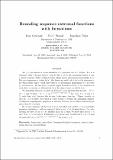Bounding sequence extremal functions with formations
Author(s)
Geneson, Jesse; Prasad, Rohil; Tidor, Jonathan
DownloadGeneson-2014-Bounding sequence.pdf (361.5Kb)
PUBLISHER_CC
Publisher with Creative Commons License
Creative Commons Attribution
Terms of use
Metadata
Show full item recordAbstract
An (r,s)-formation is a concatenation of s permutations of r letters. If u is a sequence with r distinct letters, then let Ex(u,n) be the maximum length of any r-sparse sequence with n distinct letters which has no subsequence isomorphic to u. For every sequence u define fw(u), the formation width of u, to be the minimum s for which there exists r such that there is a subsequence isomorphic to u in every (r,s)-formation. We use fw(u) to prove upper bounds on Ex(u,n) for sequences u such that u contains an alternation with the same formation width as u.
We generalize Nivasch's bounds on Ex((ab)[superscript t],n) by showing that fw((12…l)[superscript t]) = 2t − 1 and Ex((12…l)[superscript t],n) = n2[superscript [1 over (t−2)!]α(n)t−2±O(α(n)t−3)] for every l ≥ 2 and t ≥ 3, such that α(n) denotes the inverse Ackermann function. Upper bounds on Ex((12…l)[superscript t],n) have been used in other papers to bound the maximum number of edges in k-quasiplanar graphs on n vertices with no pair of edges intersecting in more than O(1) points.
If u is any sequence of the form avav′a such that a is a letter, v is a nonempty sequence excluding a with no repeated letters and v′ is obtained from v by only moving the first letter of v to another place in v, then we show that fw(u) = 4 and Ex(u,n) = Θ(nα(n)). Furthermore we prove that fw(abc(acb)[superscript t]) = 2t + 1 and Ex(abc(acb)[superscript t],n) = n2[superscript [1 over (t−1)!]α(n)t−1±O(α(n)t−2)] for every t ≥ 2.
Date issued
2014-08Department
Massachusetts Institute of Technology. Department of MathematicsJournal
Electronic Journal of Combinatorics
Publisher
Electronic Journal of Combinatorics
Citation
Geneson, Jesse, Rohil Prasad, and Jonathan Tidor. "Bounding sequence extremal functions with formations." The Electronic Journal of Combinatorics Volume 21, Issue 3 (2014).
Version: Final published version
ISSN
1077-8926